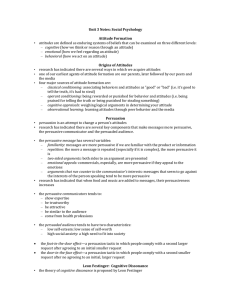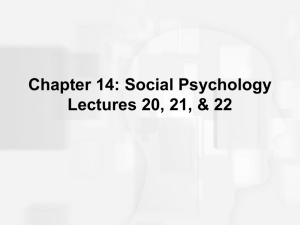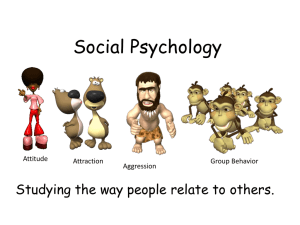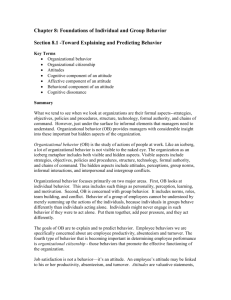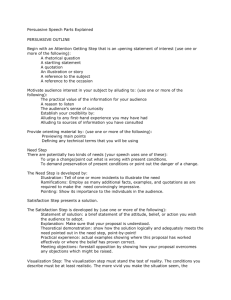Unit 3 Notes: Social Psychology Attitude Formation • attitudes are
advertisement
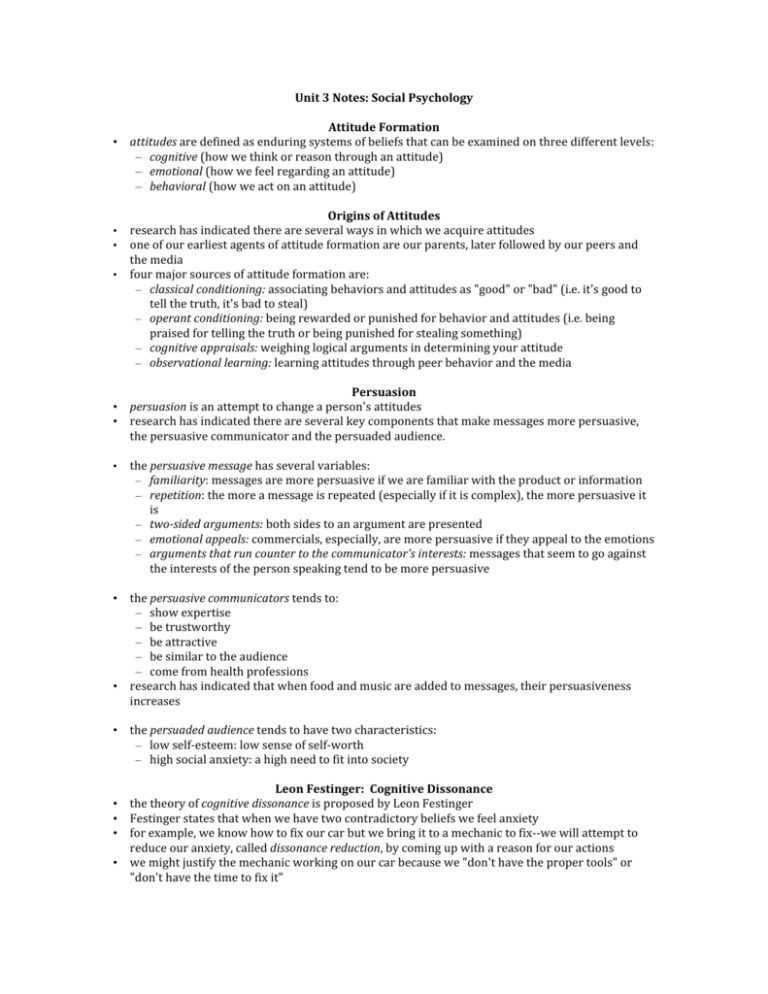
Unit 3 Notes: Social Psychology • Attitude Formation attitudes are defined as enduring systems of beliefs that can be examined on three different levels: – cognitive (how we think or reason through an attitude) – emotional (how we feel regarding an attitude) – behavioral (how we act on an attitude) • • • • • • • • • Origins of Attitudes research has indicated there are several ways in which we acquire attitudes one of our earliest agents of attitude formation are our parents, later followed by our peers and the media four major sources of attitude formation are: – classical conditioning: associating behaviors and attitudes as "good" or "bad" (i.e. it's good to tell the truth, it's bad to steal) – operant conditioning: being rewarded or punished for behavior and attitudes (i.e. being praised for telling the truth or being punished for stealing something) – cognitive appraisals: weighing logical arguments in determining your attitude – observational learning: learning attitudes through peer behavior and the media Persuasion persuasion is an attempt to change a person's attitudes research has indicated there are several key components that make messages more persuasive, the persuasive communicator and the persuaded audience. the persuasive message has several variables: – familiarity: messages are more persuasive if we are familiar with the product or information – repetition: the more a message is repeated (especially if it is complex), the more persuasive it is – two­sided arguments: both sides to an argument are presented – emotional appeals: commercials, especially, are more persuasive if they appeal to the emotions – arguments that run counter to the communicator's interests: messages that seem to go against the interests of the person speaking tend to be more persuasive the persuasive communicators tends to: – show expertise – be trustworthy – be attractive – be similar to the audience – come from health professions research has indicated that when food and music are added to messages, their persuasiveness increases the persuaded audience tends to have two characteristics: – low self‐esteem: low sense of self‐worth – high social anxiety: a high need to fit into society • • • • Leon Festinger: Cognitive Dissonance the theory of cognitive dissonance is proposed by Leon Festinger Festinger states that when we have two contradictory beliefs we feel anxiety for example, we know how to fix our car but we bring it to a mechanic to fix‐‐we will attempt to reduce our anxiety, called dissonance reduction, by coming up with a reason for our actions we might justify the mechanic working on our car because we "don't have the proper tools" or "don't have the time to fix it" • • • • • • • cognitive dissonance also occurs when our thoughts and behaviors are inconsistent – a person knows smoking cigarettes is bad for his health but smokes them anyway; he may rationalize this by saying "he's not smoking that much" or "evidence is contradictory on the effects of smoking on health" cognitive dissonance also operates on the idea that "you get what you pay for" – the thinking that something that costs more must be of higher quality explains this – the idea behind this is the more you must give up for something (money) the more valuable it must be (higher quality) patrons at a movie matinee will more likely rate the movie as moderately entertaining whereas patrons at an evening performance will rate it significantly higher or lower because they've paid more for the movie Balance Theory balance theory is also used to explain our attitudes and anxiety related to people we know. There are three possible states in balance theory: – balance: when someone we like holds the same attitudes as we do – imbalance: when someone we like holds a contradictory attitude to ours – nonbalance: when someone we don't like holds a contradictory attitude to ours Interpersonal Attraction studies conducted among college students have indicated that the number one thing males look for in a long‐term interpersonal relationship is looks the number one thing females look for is personality proximity, or the physical closeness of one person to another, is the most important characteristic, according to research • • • • • • • • Other Factors in Attraction there are several other factors involved in interpersonal attraction: – attitudinal similarity: research suggests we are more attracted to people who share the same attitudes as we do – the "Romeo and Juliet" effect: early in a relationship, parental disapproval can actually intensify feelings of interpersonal attraction – propinquity: attraction is likely to develop between people in close proximity because they will see more of the other person's inner qualities – playing hard to get: playing hard to get is actually seen as an undesirable attitude; devotional behavior, or channeling attention to only one person, is seen as most desirable Body Language body language has been studied with varying results most research indicates that the eyes can express when someone is paying attention or lying crossed arms and legs can be signs of defensiveness rapporting is the unconscious act of mirroring the body posture of someone you're talking to; if you cross your arms, the person talking to you may do the same thing Eye movements correspond to how we access parts of the brain Where a person looks when thinking can indicate whether they are recalling information, making it up, telling the truth or telling a lie. Personal Space personal space is the imaginary area we keep around ourselves to be comfortable in varying social situations • • • • • • • • there are four levels to personal space: – intimate distance: contact to 18 inches, the space we reserve for intimacies and loved ones – personal distance: 18 inches to 4 feet, the space we have around us in most social settings at school (e.g. the distance between a student and the student sitting next to them) – social distance: 4 to 7 feet, the space we have around us when we're out in public places, like the mall – public distance: 7 feet and greater, the space between us and performers at public events (e.g. concerts, lectures) research had indicated there are both cultural and gender differences in the parameters of personal space Attribution Theory attribution theory examines how we attribute the source of our actions – dispositional attribution attributes our behaviors to personal factors – situational attribution attributes our behaviors to outside factors beyond our control – defensive attribution is the tendency to attribute our successes to our own efforts (dispositional) and our failures to external factors (situational) – fundamental attribution error is the tendency of people to overemphasize personal causes for other people’s behavior (dispositional) and underemphasize personal causes for their own behavior (dispositional) Solomon Asch: Conformity the two landmark studies on conformity and obedience were conducted by Asch and Milgram, respectively. conformity is defined as voluntarily yielding to social norms, even at the expense of one's own preferences Solomon Asch conducted an experiment in which subjects were asked to compare the lengths of lines confederates, or subjects in on the experiment, purposely gave wrong answers to see if the test subjects would conform several variables that would increase the likelihood that the subjects would conform were found: – subjects would conform up to the addition of four confederates; after that the incidence of conformity stayed about the same – the serial position (when they were asked their answer) mattered, the closer to the beginning of the group would yield less conformity than being asked toward the end of the group – if confederates were unanimous in their answers, more conformity would take place; if one confederate provided a different answer, more nonconformity would take place – the more ambiguous was task was, the more likely conformity would take place – if the subject has low self‐esteem or felt not as competent as others in the group, more conformity would take place • • • • • • Stanley Milgram: Obedience to Authority obedience is defined as a change in behavior in response to a command from another person, typically an authority figure Stanley Milgram conducted an experiment to test a subject's likelihood to obey an authority figure Milgram asked students do deliver electric shocks to subjects who answered incorrectly on a series of questions they were flip switches on a mechanical box that indicated each subsequent switch delivered a slightly higher shock the last few switches indicated that the voltage was severe he found that 65% of the subjects would obey his requests to shock the subjects in the other room (who, of course, we in on the experiment as confederates and were not getting shocked) • • several variables were identified before Milgram was forced to shut down this highly controversial experiment: we are more likely to obey when – we perceive the figure requesting we obey as an authority – we are far removed from the person we are inflicting pain on (e.g. it's easier to break up with someone over the phone) – the act is shared by others (diffusion of responsibility) – the authority figure is present (e.g. when Mr. Sisman's comes out to check to see if people outside are working) • • • • • Group Behavior social facilitation has been seen in group behavior – we tend to speed up our actions when others are present – runners tend to run faster in groups than individually – animals running in packs then to run faster than individually social loafing occurs when the presence of others slows down our actions evaluation apprehension is the fear that others are evaluating our behaviors – the most common instance of this is fear of public speaking because others are focusing on the mistakes and mannerisms we make rather than the content of our speech in group decision making, polarization tends to occur – this means that groups will tend to either make extremely cautious or extremely risky decisions, whereas individuals acting alone will tend to be much more conservative in their decision making – more likely than not, groups will tend to pursue the riskier course; this is called risky shift – the reason this occurs is called diffusion of responsibility, or the idea that responsibility is shared by the group rather than just one individual in groups, individuals can get so caught up in the "group mentality" that they can lose a sense of self and personal responsibility; this is called deindividuation • • • • Leadership Styles there are basically three types of leadership style: – autocratic is a style in which the group leader makes all the decisions – democratic is a style in which members of the group provide input to the leader in making decisions, often based on majority vote – laissez­faire is a style in which the group is allowed to pursue whatever course it wants; there is a general absence of autocratic or democratic leadership Types of Power leaders in a group can wield one or more of five types of power: – expert power occurs when the leader is perceived as an expert in the field – legitimate power occurs when the leader has on official position that gives him or her statutory or perceive power – referent power occurs when a leader is well‐liked by the group – reward power occurs when the leader can bestow benefits or rewards to group members – coercive power occurs when the leader can punish group members Altruistic Behavior the 1964 rape and murder of Kitty Genovese, where nearly 40 people witnessed what was happening yet no one called the police, has prompted social psychologists to understand the parameters of helping behavior witnesses of the Genovese killing in New York said they didn't response because: – they thought someone else would call the police – they didn't want to get involved • • • • • • • • • • research indicates the following regarding helping behavior: the helper: we typically help when... – we are in a good mood – we have empathy for the victim – we are NOT highly masculine (highly masculine helpers fear potential embarrassment if they can't successfully help) – we feel as sense of personal responsibility – we possess the behavioral competency to help the victim: Individuals are more likely to be helped if they are... – female – attractive – alone – similar to the helper situational determinants: We are more likely to help if... – we fully understand what we are seeing – there are no other bystanders around – we are acquainted with the victim – the environment is familiar to the helper Environmental Psychology various studies on the effects of noise have been conducted on children who live in the landing patterns of major airports and on the lower levels of tenement housing along busy streets in cities results indicate that these children suffer from: – more stress – more hearing loss – deficits in learning and memory ability studies done at loud clubs and discos have shown that when noise levels exceed 80 decibels, feelings of interpersonal attraction start to decrease and couple increase the space between them John Calhoun: Density and Crowding John Calhoun is known best for his studies on density and crowding he created a "rat universe" in which rats were allowed to reproduce until their container, or "universe" became crowded he noted several forms of aberrant behavior: – mortality rate rose – the family structure broke down – packs of delinquent male rats would terrorize others in the container • • • • • Crowding in Human Environments studies of density and crowding have also been conducted in human environments prisoners at crowded prisons show higher blood pressure, a higher mortality rate and more mental disorders students in crowded college dormitories show less satisfaction with their roommate and tend to withdraw more from social interaction the tripling effect has also been observed in some dorm room situations; when three students room together, a friendship can develop between two of them and their third will feel ostracized or left out research on city dwellers has found that they tend to shake hands less, they do not help strangers and they tend to plan ahead, especially when walking, to avoid potential dangers • • • • • Industrial/Organizational Psychology industrial/organizational (I/0) psychology is concerned with the application of psychological principles to the problems of human organizations, especially work organizations Elton Mayo conducted the first experiments during the 1920s to determine if increasing the lighting in the Western Electric Hawthorne plant would increase productivity – results indicated any changes in the lighting, high or low, increased productivity, but not because of the lighting – workers knew they were being observed and increased their productivity as a result of being watched the Hawthorne effect is the principle that people will alter their behavior because of researchers’ attention and not necessarily because of any treatment condition further research has advanced the understanding of work organizations. Results of studies have found: – workers who employ a variety of skills on the job are more likely to view their jobs as meaningful, show increased motivation and have more satisfaction with their job – workers who are more autonomous perceive their jobs as entailing more responsibility and produce higher quality work – small, cohesive work groups are more productive than large, impersonal ones—employers have moved from assembly line – workers to autonomous work groups who produce an entire unit—this has led to greater worker satisfaction, higher‐quality output and decreased absenteeism research on communication and responsibility have found: – centralized communication schemes work better in solving simple problems while solving complex problems requires less centralization with members freely communicating among themselves – assigning key decisions to work groups improves satisfaction with the outcome and their membership in the group – increasing the number of people who participate in decision making does not lead to increased productivity
